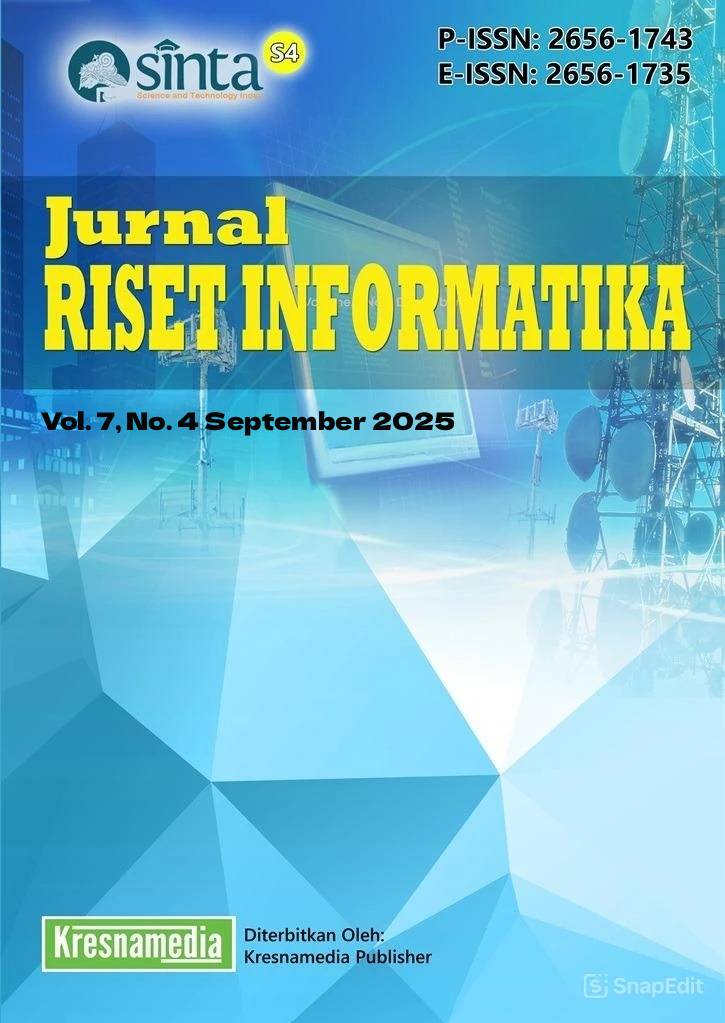Prototype of an Automatic Height and Weight Measurement System Based on Z-Scores for Determining the Nutritional Status of Toddlers
DOI:
https://doi.org/10.34288/jri.v7i4.421Keywords:
Automated Height and Weight Measurement System, Z-Score, Nutritional Status, Children Aged 24-60 months, WHO Child Growth StandardsAbstract
Monitoring the nutritional status of children aged 24-60 months is a crucial aspect of ensuring their growth and development. The commonly used manual methods often have limitations in terms of accuracy and efficiency. This study aims to design and develop a prototype of an automated height and weight measurement system based on Z-Score to accurately and efficiently determine the nutritional status of children. The system is developed using the ESP8266 microcontroller as the control center, integrating an RFID module for child identification, an ultrasonic sensor for height measurement, and a load cell for weight measurement. The measurement data is then processed to generate a Z-Score value, which is displayed on an LCD screen. Based on the test results, the system demonstrates a measurement accuracy of 99.60% for children's height and weight. Additionally, the nutritional status assessment aligns with WHO standards. This system is expected to enhance the effectiveness and efficiency of nutritional monitoring for toddlers.
Downloads
References
REFERENCES
Anggari, A. A. I. I., Suyasa, I. G. P. D., & Wulandari, I. A. (2021). Gambaran Kunjungan Balita ke Posyandu dan Status Gizi Balita Pada Masa Pandemi Covid-19 di Desa Buahan Kaja Kabupaten Gianyar Tahun 2020. Jurnal Riset Kesehatan Nasional, 5(2), 126–130. https://doi.org/10.37294/jrkn.v5i2.338
Apriningtyas, V. N., & Kristini, T. D. (2019). Faktor Prenatal yang Berhubungan dengan Kejadian Stunting Anak Usia 6-24 Bulan. Jurnal Kesehatan Masyarakat Indonesia, 14(2), 13–17. https://doi.org/10.26714/jkmi.14.2.2019.13-17
Arini, D., & Faradilah, I. (2020). The Incidence of Stunting and the Frequency and Duration of Diarrhea in Toddler. Kemas, 16(2), 233–240. https://doi.org/10.15294/kemas.v16i2.20032
BKPP Kemenkes RI. (2023, January 25). Prevalensi Stunting di Indonesia Turun ke 21,6% dari 24,4%. Website Kemenkes RI. https://kemkes.go.id/id/prevalensi-stunting-di-indonesia-turun-ke-216-dari-244
DitGizi Kemenkes RI. (2018). Hasil Pemantauan Status Gizi (PSG) Tahun 2017. https://sehatnegeriku.kemkes.go.id/wp-content/uploads/2018/01/Buku-Saku-Nasional-PSG-2017-Cetak-1.pdf
Faizal, Moch., Sulistiyowati, I., Jamaaluddin, J., & Anshory, I. (2023). Design of a Height and Weight Measurement Tool for Toddlers at Spreadsheet-Based Posyandu. JEEE-U (Journal of Electrical and Electronic Engineering-UMSIDA), 7(2), 163–175. https://doi.org/10.21070/jeeeu.v7i2.1677
Fauzi, S. W., Sitti Nurfebruary, N., Ula, M., Nisa, F., & Ikhwani, M. (2025). Perancangan Alat Pengukuran Tinggi dan Berat Badan Berbasis Internet of Things Untuk Deteksi Stunting pada Bayi Usia 1-12 Bulan di Posyandu (Studi Kasus Gampong Rayeuk Kareung). Journal of Science and Social Research, 8(3), 5189–5195. https://doi.org/10.54314/jssr.v8i3.3969
Fauziah, J., Trisnawati, K. D., Rini, K. P. S., & Putri, S. U. (2023). Stunting: Penyebab, Gejala, dan Pencegahan. Jurnal Parenting Dan Anak, 1(2), 11. https://doi.org/10.47134/jpa.v1i2.220
Firmansyah, D. A., Saragih, I. M. L., & Yasri, B. (2024). Purwarupa Alat Ukur Bobot dan Tinggi Badan Batita Berbasis Arduino. Journal of Electrical Engineering, 1(2), 1–17. https://doi.org/10.47134/jte.v1i2.2965
Gannika, L. (2023). Hubungan Status Gizi dengan Tumbuh Kembang Pada Anak Usia 1-5 Tahun: Literature Review. Ners, 7(1), 668–674. https://doi.org/10.31004/jn.v7i1.14198
Gunawan, & Ash Shofar, I. N. (2018). Penentuan Status Gizi Balita Berbasis Web Menggunakan Metode Z-Score. Infotronik, 3(2), 120–125. https://doi.org/10.32897/infotronik.2018.3.2.111
Ilham, Yulianto, R., & Amiruddin, A. (2022). Sistem Pengukur Berat Badan dan Tinggi Badan dengan Pencatatan Otomatis Berbasis Internet of Things. Journal of Natural Science and Technology Adpertisi, 2(2), 24–32. https://doi.org/10.62728/jnsta.v2i2.342
Kirana, S. Z., & Gani, A. (2023). Peran Pos Pelayanan Terpadu (Posyandu) dalam Meningkatkan Kesehatan Ibu Hamil di Indonesia. Jurnal Cahaya Mandalika, 4(2), 171–180. https://doi.org/10.36312/jcm.v4i2.1518
Kusuma, A. N. (2022). The Presence of Posyandu as an Approach in Improving Health Development in the Community. Jurnal Eduhealt, 13(01), 137–146. http://ejournal.seaninstitute.or.id/index.php/healt
Maulana, D. R., Rohana, T., & Pratama, A. R. (2021). Alat Ukur dan Pencatat Otomatis Tinggi dan Berat Badan Balita Berbasis Arduino. Scientific Student Journal for Information, Technology and Science, 2(1), 191–196.
Menteri Kesehatan RI. (2020). Permenkes Nomor 2 Tahun 2020 Tentang Standar Antropometri Anak. https://paralegal.id/peraturan/peraturan-menteri-kesehatan-nomor-2-tahun-2020/
Pratiwi, N., Jaladri, I., Gitning, M., Andini Jurusan Gizi, L., & Kemenkes Pontianak, P. (2024). Kajian Literatur Tentang Perkembangan Portabel Digital Dalam Mengukur Tinggi Badan Pada Balita. Media Gizi Khatulistiwa, 1, 1–6. https://doi.org/10.2804/mgk.1811.1016
Prayogie, A., Fauziah, A., & Syamsul. (2022). Alat Pengukur Tinggi dan Berat Badan Otomatis Menggunakan Sensor Ultrasonic dan LoadCell Berbasis Internet of Things. TEKTRO, 6(1), 38–43. https://doi.org/10.30811/tektro.v6i1.3214
Sarumaha, A. L., & Panjaitan, C. E. (2025). Pengukuran Tinggi Badan Dan Berat Badan Anak-Anak Berbasis IOT Menggunakan Arduino UNO. Informatic Technique Journal, 2(2), 43–55. https://upu-journal.potensi-utama.org/index.php/itjournal/article/view/1122
Umiatin, U., Erlandita, S. M., & Indrasari, W. (2019). Design baby mass and height monitoring system based on Arduino and Android application. AIP Conference Proceedings, 2169. https://doi.org/10.1063/1.5132663
WHO International. (2025a). Weight-for-height BOYS 2 to 5 years (z-scores). https://cdn.who.int/media/docs/default-source/child-growth/child-growth-standards/indicators/weight-for-length-height/wfh-boys-2-5-zscores.pdf?sfvrsn=66c3e6fe_9
WHO International. (2025b). Weight-for-height GIRLS 2 to 5 years (z-scores). https://cdn.who.int/media/docs/default-source/child-growth/child-growth-standards/indicators/weight-for-length-height/wfh-girls-2-5-zscores.pdf?sfvrsn=3dc8f085_9
Zulfiani, E., Layinatul Fuadah, L., Ilmu Kesehatan, F., & Islam Al-Ihya Kuningan, U. (2024). Peran Gizi dan Ahli Gizi Dalam Upaya Pembangunan Nasional di Indonesia. JUSINDO, 6(1), 211–217. https://doi.org/10.59141/jsi.v6i01.76
Downloads
Published
How to Cite
Issue
Section
License
Copyright (c) 2025 Maylaf Fayza, Dr. Robby Kurniawan Harahap, Dr. Foni Agus Setiawan

This work is licensed under a Creative Commons Attribution-NonCommercial 4.0 International License.
The Jurnal Riset Informatika has legal rules for accessing digital electronic articles uunder a Creative Commons Attribution-NonCommercial 4.0 International License . Articles published in Jurnal Riset Informatika, provide Open Access, for the purpose of scientific development, research, and libraries.

















